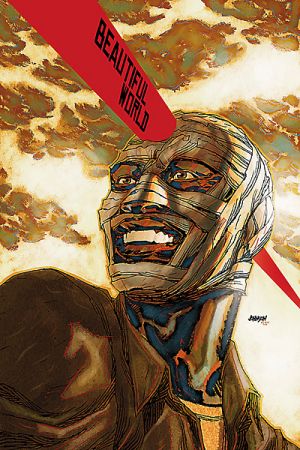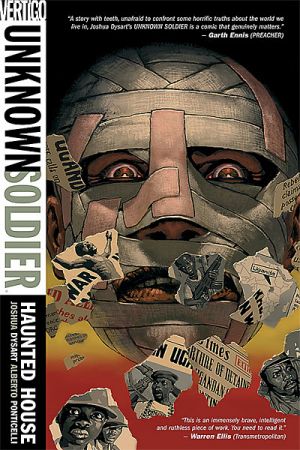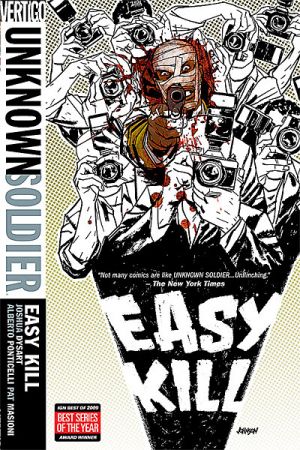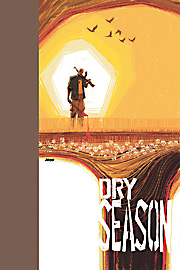- Comics
- Comics Reviews
- Manga
- Comics Reviews
- European Comics
- News
- Comics News
- Press Releases
- Columns
- Spotlight
- Digital Comics
- Webcomics
- Cult Favorite
- Back Issues
- Webcomics
- Movies
- Toys
- Store
- More
- About
By Andy Frisk
November 14, 2010 - 21:46
In the final chapter of “Beautiful World” Joshua Dysart and Alberto Ponticelli bring to an end their two year long journey into the heart of darkness that is war and terrorist torn East Africa. Unknown Soldier told the unique story of an American operative trained and psychologically conditioned to act as an agent of the US government and CIA in the region. His conditioning isn’t complete though as an unknown soldier who served the US and CIA during the Second World War and the Cold War (and who’s story is well documented in the annals of DC Comics’ history and a brilliant Garth Ennis penned Vertigo series) gave Moses Lwanga, the Unknown Solider, an opportunity to achieve a peace that he was unable to in his life. Lwanga does finally achieve peace…but not in the way he desired. Unknown Soldier ends with issue #25, and so does the story of its protagonist set in the all too real world of East African conflict that Dysart managed to bring attention to. With this end, the world of sequential art loses one of its best and most relevant series and characters.
 |
The way that Dysart brings his series and the tale of his soldier to an end is bitingly, and sorrowfully, realistic. Lwanga fails to change the world in the way he desires, but like this unfortunately little read comic book, Lwanga made a lasting impression on his target audience and managed to succeed in inspiring a younger generation to stand up against tyranny. Realistically, it would have been inappropriate historically for Lwanga to succeed in his mission to kill Kony. Kony is still very much alive in the real world, and is still the dangerous face of East African oppression. His Christian Lord’s Resistance Army continues to recruit and exploit child soldiers and commit human rights atrocities. Dysart’s passion for illuminating the story of an oft ignored conflict and the human rights atrocities surrounding this conflict was very well articulated and brought to life over the course of Unknown Soldier’s twenty-five issue run. It’s sad that a work of such intelligence, realism, and moral integrity couldn’t find a strong readership. Yes, it was a harsh book that dealt with harsh subjects. Perhaps the casual reader who picked up the series was dumbfounded by the presence of an African-American Unknown Soldier character operating in modern day East Africa instead of their dim recollection of the original character. Perhaps Dysart’s early on text pages on the history of Kony, the LRA, and the conflicts in Sudan and Uganda were too academic for a mainstream comic book (it wasn’t for Watchmen). Perhaps, because of these facts, Unknown Soldier was just too much for the mainstream comic book reader to swallow. Sadly, Vertigo readers should be of a higher attention span and be able to invest the time necessary to absorb and appreciate this tale. Perhaps, they’re not…It is a comforting fact though that a series of this quality did last for two years and was published by a very large mainstream publisher. DC Comics’ Vertigo line remains one of the most experimental and literary lines of comic books published, and I salute Time Warner and DC Comics for continuing to publish, and therefore exposing the at large comic book reading public to, a line of books that might not be spectacular sellers and profit margin boosters, but are more literary and intelligent in nature than 90% of the drivel that they and Marvel Comics publish monthly.
 |
Granted, Unknown Soldier wasn’t a perfect series. There are few perfect series. Dysart did take a little long establishing the link between his current Soldier with the Soldier of the past even though he hinted at this link early on in the series. He also left pretty underdeveloped the story of rogue CIA operative Jack Lee Howl, who was mostly likely intended to be the Soldier’s handler to an extent. Granted again though, Dysart really didn’t get much time to really get into the original Soldier’s connection to Lwanga and Howl’s back story. The brilliance that Dysart did display with tales like “Kalashnikov” in issue #21 were glimpses of what could have been if Unknown Soldier continued on and was allowed to sprawl like many of the great Vertigo series do and tackle related if not plot specific issues that thematically relate to the theme of the series overall.
 |
While Unknown Soldier might have had its minor flaws, one area that was flawless was the art. Ponticelli’s style isn’t similar at all to the style of most mainstream comic book artists. The most popular style being what I’ve oft referred to as the “Jim Lee School” of style. Muscle bound men and well (more like impossibly) endowed women dominate this style, as does a heavy dose of sci-fi and gun fetish. Ponticelli’s characters looked jagged and unrealistic at times as well, but this uneasiness of anatomic continuity helped to reinforce the sense of despair and frailty that settled in the very bones and bodies of the victims, most of which were children, of Kony’s army in the book. The jaggedness of the artwork also conjured the sense that tranquil scenes could erupt into scenes of horrific violence at any moment. The tension is always just under the surface.
 |
Overall, I enjoyed this series immensely, and hopefully I was just one of many, even if we were collectively too little of a readership to warrant the series’ continuance. It’s a series that I highly recommend to any discerning reader. The final issues will undoubtedly be collected in trade form to go along with the already published ones, so Dysart’s tale will live on in trade paperback form. I’ve been incredibly privileged to chat with Mr. Dysart via email and express my disappointment at his series’ cancellation. When I asked him about his future plans, he was unfortunately not at liberty to say, but I’m sure that whatever he is working on will be a worthy read as well. He’s a talent who should be much in demand for some time to come. I for one would love to see what he would do helming a series starring the original Unknown Soldier. He would have the opportunity to tell the same type of thematically important stories, but with a more recognizable character in a more recognizable setting. I can only hope though…and as a fan of Dysart’s work, I’ll be sure to follow him to wherever his career leads him next. I’m sure that he still has some great stories to tell…hopefully we’ll see them sooner than later.
Rating: 10 /10